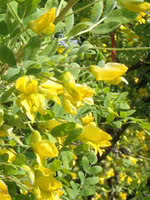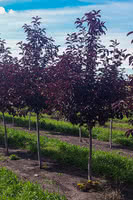Mon-Fri 9am - 5pm Mountain time
Common Caragana vs Robert Chokecherry
Caragana arborescens
Prunus virginiana Robert
NOT AVAILABLE THIS SEASON - MIGHT RETURN
Common Caragana is a fast growing shrub that's known for its exceptional hardiness and drought tolerance. Although it's most commonly planted in shelterbelts, Common Caragana is also an excellent hedge or feature shrub.
Note: in warmer areas, this species can be difficult to contain once planted. Use the right plant in the right place.
Developed in Barrhead, Alberta, the Robert Chokecherry produces very large berries (comparable to the size of grapes) with good yield.
The berries can be used for wine, jams, jellies and fresh picking, making it one of the sweeter chokecherries. Rich, red foliage make it a striking landscape addition.
Common Caragana Quick Facts
Robert Chokecherry Quick Facts
Toxicity: Toxic to animals with segmented stomachs (horses, cattle, deer moose, etc.)
In row spacing: 0.3 m (1.0 ft)

